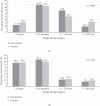Weight Change and Its Association with Cardiometabolic Risk Markers in Overweight and Obese Women
- PMID: 32399286
- PMCID: PMC7211250
- DOI: 10.1155/2020/3198326
Weight Change and Its Association with Cardiometabolic Risk Markers in Overweight and Obese Women
Abstract
Objectives: To examine the association of weight loss magnitude with changes in cardiometabolic risk markers in overweight and obese women from low socioeconomic areas engaged in a lifestyle intervention.
Methods: Analyses were performed on 243 women (mean body mass index 31.27 ± 4.14 kg/m2) who completed a 12-month lifestyle intervention in low socioeconomic communities in Klang Valley, Malaysia. Analysis of covariance (ANCOVA) was used to compare changes of cardiometabolic risk factors across weight change categories (2% gain, ±2% maintain, >2 to <5% loss, and 5 to 20% loss) within intervention and control group.
Results: A graded association for changes in waist circumference, fasting insulin, and total cholesterol (p=0.002, for all variables) across the weight change categories were observed within the intervention group at six months postintervention. Participants who lost 5 to 20% of weight had the greatest improvements in those risk markers (-5.67 cm CI: -7.98 to -3.36, -4.27 μU/mL CI: -7.35, -1.19, and -0.59 mmol/L CI: -.99, -0.19, respectively) compared to those who did not. Those who lost >2% to <5% weight reduced more waist circumference (-4.24 cm CI: -5.44 to -3.04) and fasting insulin (-0.36 μU/mL CI: -1.95 to 1.24) than those who maintained or gained weight. No significant association was detected in changes of risk markers across the weight change categories within the control group except for waist circumference and adiponectin.
Conclusion: Weight loss of >2 to <5% obtained through lifestyle intervention may represent a reasonable initial weight loss target for women in the low socioeconomic community as it led to improvements in selected risk markers, particularly of diabetes risk.
Copyright © 2020 Liyana Ahmad Zamri et al.
Conflict of interest statement
The authors declare no conflicts of interest.
Figures

References
-
- WHO. Noncommunicable Diseases Country Profiles 2011. Geneva, Switzerland: World Health Organization; 2011.
Publication types
MeSH terms
LinkOut - more resources
Full Text Sources
Medical

